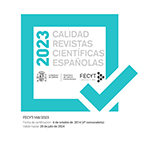Lingering Wars: Deciphering the Valley of the Fallen in Contemporary Spain
Abstract
The most recent cycle of exhumations of Spanish Civil War (1936-1939) and Postwar Mass Graves, which started in the year 2000, has affected very specially the location, digging and dignification of those mass graves originated by the rebel army’s rearguard repression during the War and, later, in the early Postwar years of Francoism. These diggings have inevitably drawn the country’s attention to the most uncanny of all National Catholic monuments in the country, The Valley of the Fallen, inaugurated by Franco in 1959 and which was to become his own mausoleum in 1975. In-between 1959 and 1983, more than 30,000 copses from Civil War casualties were drawn to the monument’s crypts. This paper analyzes the contemporary debates in Spain on the nature and possible fate of this controversial monument by following some aspects of Fausto Canales’ life story, a retired engineer who set out to exhume the body of his father and six other neighbours from the mass grave in which they had been thrown by members of falange (Spanish Fascist Party) in August of 1936 in the municipality of Aldeaseca (Ávila). After realizing that the mass grave was empty, they discovered that the bodies had been exhumed in 1959 to be transported to the Valley of the Fallen without any permission or knowledge from their relatives. Aldeaseca’s discovery has been crucial in bringing to public life the fact that corpses of Republicans, and not only Franco’s loyalists, had been brought to El Valle in still unknown numbersDownloads
Article download
License
In order to support the global exchange of knowledge, the journal Política y Sociedad is allowing unrestricted access to its content as from its publication in this electronic edition, and as such it is an open-access journal. The originals published in this journal are the property of the Complutense University of Madrid and any reproduction thereof in full or in part must cite the source. All content is distributed under a Creative Commons Attribution 4.0 use and distribution licence (CC BY 4.0). This circumstance must be expressly stated in these terms where necessary. You can view the summary and the complete legal text of the licence.











